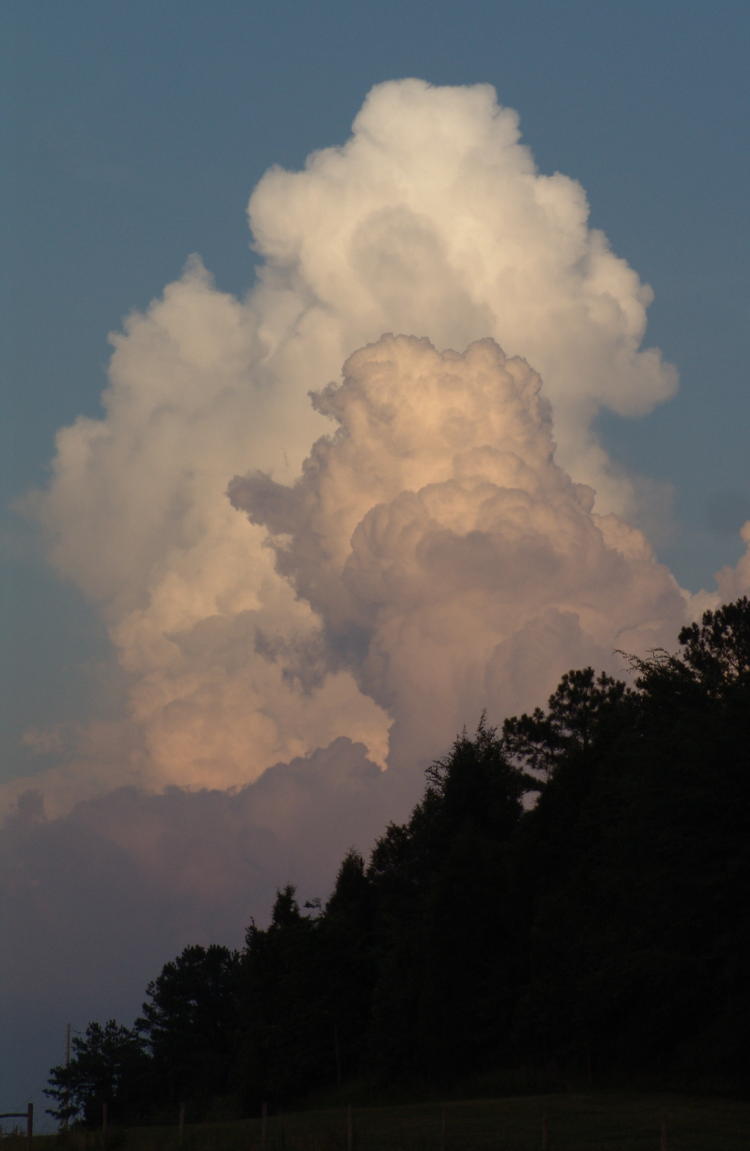
This week, we’re reminiscing about 2006 (to begin with,) a summer with a series of fierce electrical storms. These growing thunderheads were catching the light of the setting sun, so peaks of different heights and distances were getting contrasting colors dictated by the atmosphere; you’ll notice that the very bottoms, and the foreground details, had already witnessed sunset, while that back peak was still catching full sunlight from several thousand meters higher up, peeking around the curve of the earth. This somehow looks familiar…
[For your amusement, I can tell you that this is being written before the previous post was even started, but I know what I’m going to post about.]
You almost certainly noticed the curious detail down at the bottom, where the trees were emulating the cloud banks a little too well, with one small patch at bottom center breaking free before it evaporated. Though trees shouldn’t do this.
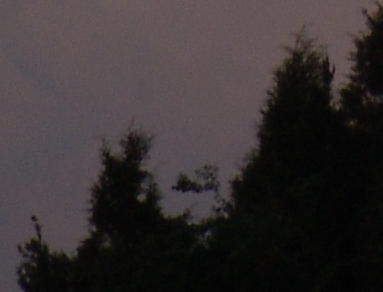 A close look at the full resolution of that now-ancient camera shows the reason: we’re just seeing an oddly-shaped bough, the supporting branch having disappeared at the lower resolution used for blog display. Damn. I thought I’d discovered some new physics.
A close look at the full resolution of that now-ancient camera shows the reason: we’re just seeing an oddly-shaped bough, the supporting branch having disappeared at the lower resolution used for blog display. Damn. I thought I’d discovered some new physics.
Oh well, on to 2009.
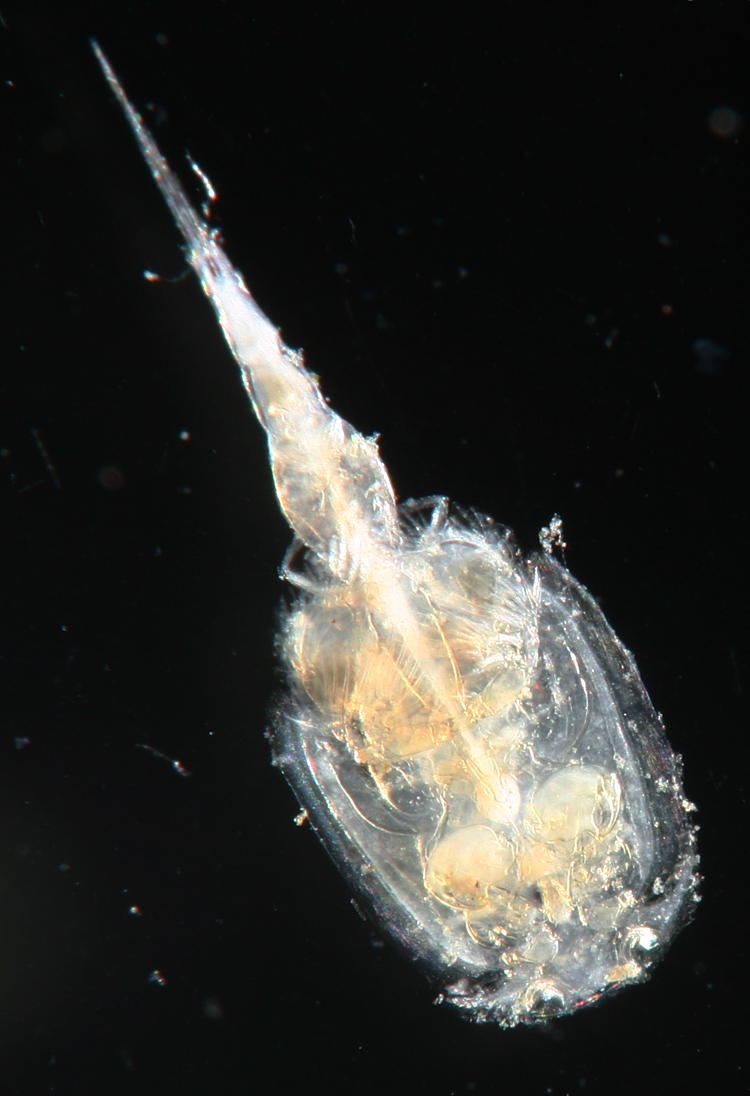
On this date 11 years ago, we’d just returned from a beach trip, where my cavorting in the surf had produced a distinct stinging sensation on my arm – not too sharp, but more than a random itch. First glance and scratch turned up nothing, but when it returned, I looked harder and found what appeared to be a freckle but wasn’t. Having come prepared that trip, I managed to scrape it off and incarcerate it within a film can for collecting specimens, and back home, I set up a super macro rig – the first time I started using the reversed 28-105 for macro, if I remember correctly. With the detailed shots, I was able to determine that this was a very young Atlantic horseshoe crab (Limulus polyphemus,) of all things, remarkably tiny when first hatched. They don’t sting, but the exoskeleton is already pretty hard and I was likely getting stabbed by the tail. Anyway, details are here, but know that my ‘extension tube’ was actually a piece of PVC pipe with adapters glued onto the ends, painted black inside.
Just so you know if you’re ever asked, I purchased that Sigma 28-105 in 1997 I believe, and the aperture failed in 2004 while in Florida; I hung onto it in case I ever found the way to repair it. So here in 2009 I started using it backwards as a high-magnification macro lens, for which it still does duty, which means it’s had a longer shooting life while broken than it had in good shape. The frustration over this and another lens’ failure, which was known and too common with Canon cameras, almost had me switching to Nikon. Turns out, the EOS system of controlling both aperture and focus motor electronically rather than physically meant that zooms had to have frequently-flexed ribbon cables within, and these are a point of weakness; I even found the damaged cable within the 28-105 later on, when I’d dismantled it and set the aperture to a fixed f16, where it remains today.
On to 2012.

I’d captured this giant stag beetle (Lucanus elaphus) while out and brought it home for an extended photo session which, as you might imagine, it bore with exceedingly bad grace, but I still managed not to get pinched. Which means I fared better than with the horseshoe crab (you know, that’s a difficult word to type instinctively, “horseshoe.”) Giant stag beetles look horrendous, but know that the ‘horns’ are more for mating than protection, and used more often on each other than anything else, especially since the females don’t actually have them. Better not to ask any further questions.
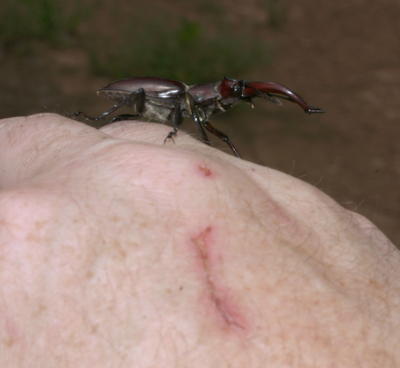 I took a lot of photos, including a couple of attempts at scale, and one of them told me a little more; that’s my right hand in the shot, which means that I’d fired this off with my left. This had to be fun, since the shutter release and grip are on the right of the camera. Meanwhile, that big ugly wound on my hand is not courtesy of the stag beetle, which did no damage whatsoever, but our washing machine instead, when the lid slammed down just as I was reaching inside. I still have that scar…
I took a lot of photos, including a couple of attempts at scale, and one of them told me a little more; that’s my right hand in the shot, which means that I’d fired this off with my left. This had to be fun, since the shutter release and grip are on the right of the camera. Meanwhile, that big ugly wound on my hand is not courtesy of the stag beetle, which did no damage whatsoever, but our washing machine instead, when the lid slammed down just as I was reaching inside. I still have that scar…
A year later, I was getting fartsy with a spider. Don’t act so surprised – you know what the blog is like.
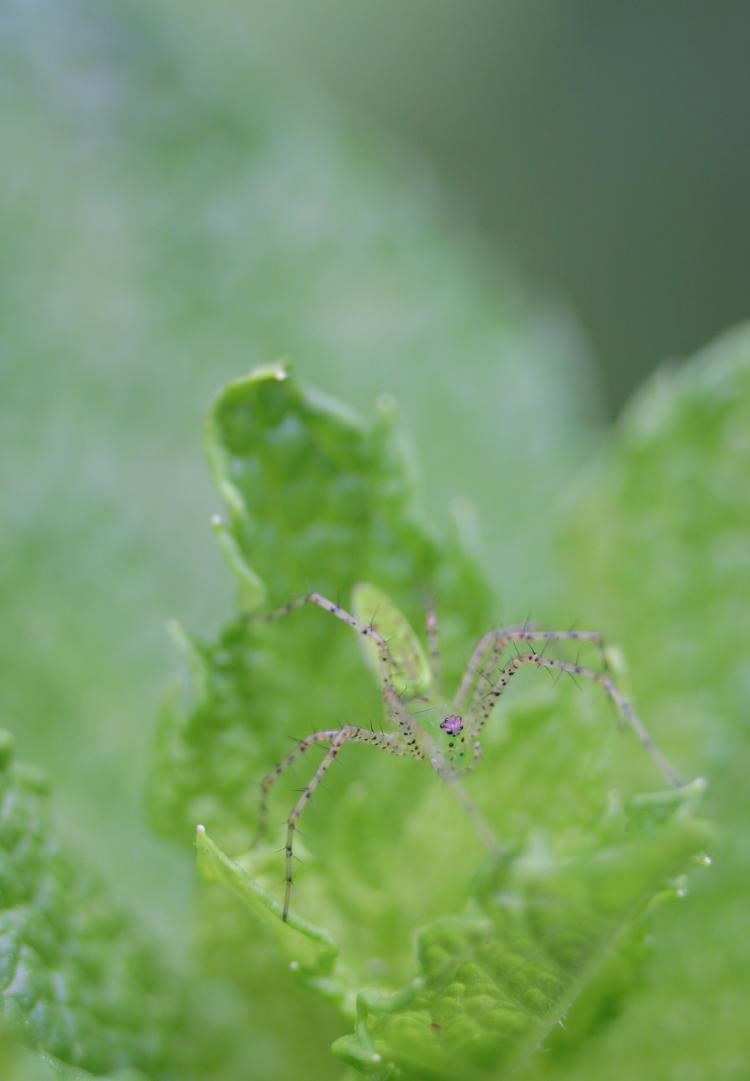
In 2013, we had a bumper crop of spearmint plants and several green lynx spiders (Peucetia viridans,) so it’s only natural to assume that they could have come together at some point – actually, quite often. This was the beginning of watching almost the entire life cycle of the lynx spiders, including the appearance of egg sacs, the birth of several broods, and even monitoring them over the winter. I had also planted the spearmint myself, which grew into an enviable patch big enough to hide even me; we have had no such luck here at the new place, but the soil at the old (where this was taken) was super rich. So I have to play around with something more than detail or identifying shots every once in a while, and shooting by natural light with a large aperture produced this effect. Yet somehow, I still don’t have my prints up in the best galleries, even just in North Carolina. Go figure.




















































